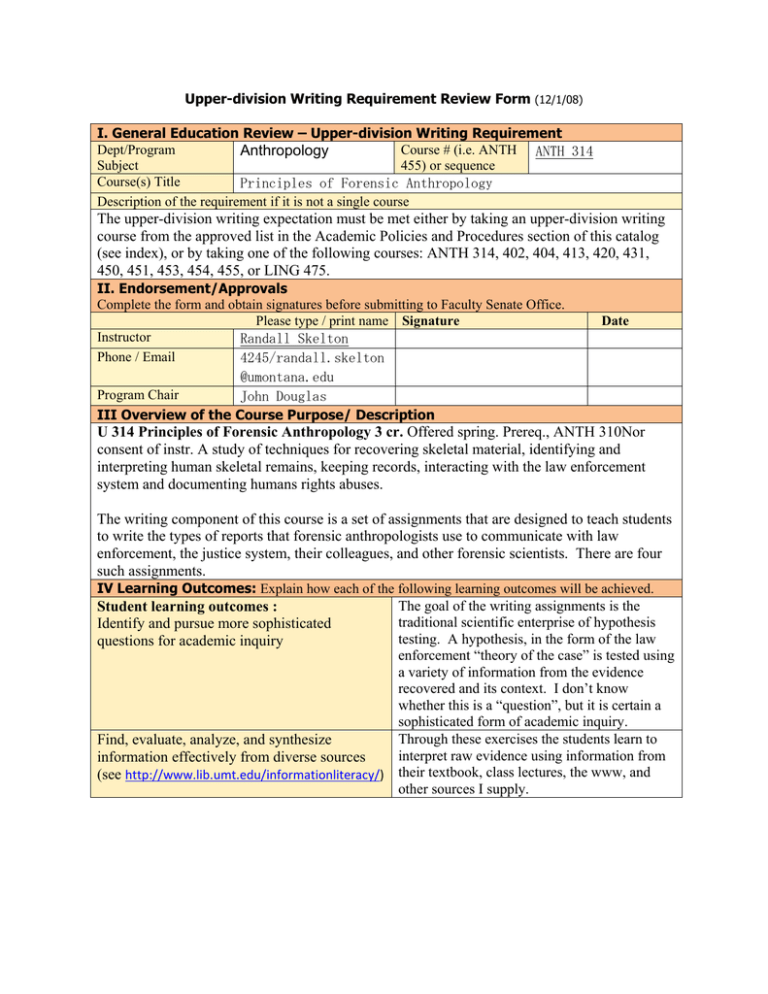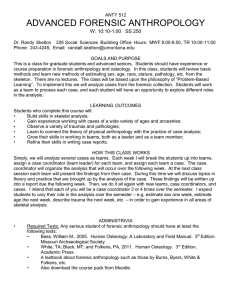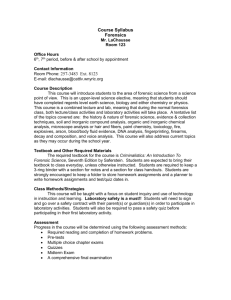Document 11902878
advertisement

Upper-division Writing Requirement Review Form (12/1/08) I. General Education Review – Upper-division Writing Requirement Dept/Program Course # (i.e. ANTH ANTH 314 Anthropology Subject 455) or sequence Course(s) Title Principles of Forensic Anthropology Description of the requirement if it is not a single course The upper-division writing expectation must be met either by taking an upper-division writing course from the approved list in the Academic Policies and Procedures section of this catalog (see index), or by taking one of the following courses: ANTH 314, 402, 404, 413, 420, 431, 450, 451, 453, 454, 455, or LING 475. II. Endorsement/Approvals Complete the form and obtain signatures before submitting to Faculty Senate Office. Please type / print name Signature Instructor Randall Skelton Phone / Email 4245/randall.skelton @umontana.edu Program Chair John Douglas III Overview of the Course Purpose/ Description Date U 314 Principles of Forensic Anthropology 3 cr. Offered spring. Prereq., ANTH 310Nor consent of instr. A study of techniques for recovering skeletal material, identifying and interpreting human skeletal remains, keeping records, interacting with the law enforcement system and documenting humans rights abuses. The writing component of this course is a set of assignments that are designed to teach students to write the types of reports that forensic anthropologists use to communicate with law enforcement, the justice system, their colleagues, and other forensic scientists. There are four such assignments. IV Learning Outcomes: Explain how each of the following learning outcomes will be achieved. The goal of the writing assignments is the Student learning outcomes : traditional scientific enterprise of hypothesis Identify and pursue more sophisticated testing. A hypothesis, in the form of the law questions for academic inquiry enforcement “theory of the case” is tested using a variety of information from the evidence recovered and its context. I don’t know whether this is a “question”, but it is certain a sophisticated form of academic inquiry. Through these exercises the students learn to Find, evaluate, analyze, and synthesize interpret raw evidence using information from information effectively from diverse sources (see http://www.lib.umt.edu/informationliteracy/) their textbook, class lectures, the www, and other sources I supply. Manage multiple perspectives as appropriate Recognize the purposes and needs of discipline-specific audiences and adopt the academic voice necessary for the chosen discipline Use multiple drafts, revision, and editing in conducting inquiry and preparing written work Follow the conventions of citation, documentation, and formal presentation appropriate to that discipline Develop competence in information technology and digital literacy In this context there are inherently two perspectives. The first, and most obvious, is a “prosecution” perspective, in which the police “theory of the case” is true at face value and therefore any suspects involved are guilty. The second is a “defense” perspective, in which the police “theory of the case” is inaccurate in some respect and therefore any suspects involved may be innocent. Students learn how to fairly test a “theory of the case” so as to achieve a balance of these two perspectives and perhaps approach a true description of the events that led to the evidence examined. Clearly, these assignments encourage students to recognize the purposes and needs of forensic anthropology and adopt the voice necessary for communicating with law enforcement and other constituencies. What is not so obvious, is that this pursuit is really just standard science. The purposes and needs of forensic anthropology are a simple subset of the purposes and needs of anthropology in general, which is in turn a subset of the purposes and needs of science in general. I don’t require revisions of drafts of entire documents, but I do require certain parts of documents to be revised and carried forward to be included in later documents. For example, assignment 2 culminates in an “inventory narrative” in which the evidence recovered is described and the minimum number of individuals present is estimated. I grade this, and students must revise any errors of writing and interpretation then include it as a portion of assignment 3. The citation and reference style is CSE. The format of their documents is according to the convention in forensic anthropology. Students must word process their documents. In addition they occasionally need to look up information on the www. V. Writing Course Requirements Check list Is enrollment capped at 25 students? If not, list maximum course enrollment. Explain how outcomes will be adequately met for this number of students. Justify the request for variance. Yes X No Enrollment is capped at 45. Average enrollment is around 30. I have a grader who grades the exams in order to give me the time to grade the written assignments. Enrollment must be set higher than 25 because this is a required course Are outcomes listed in the course syllabus? If not, how will students be informed of course expectations? for the Forensic Anthropology Option and is a prerequisite for other courses (e.g. ANTH 412). X Yes No Are detailed requirements for all written assignments including criteria for evaluation in the course syllabus? If not how and when will students be informed of written assignments? Yes X No The requirements for the written assignments are in a required coursepack, which is available for download from Blackboard or purchase from the bookstore. The coursepack is approximately 60 pages in length (depending on the case used that semester) and contains extremely details instruction on how to do the assignments and how to write the reports. Briefly explain how students are provided with tools and strategies for effective writing and editing in the major. These are presented in detail in the coursepack. They are also discussed in the text. Further, I have a formal critique of each assignment as a class lecture, in which I discuss (anonymously with respect to student identity) the best and worst of the writing I encountered. Will written assignments include an opportunity for X Yes No Portions of them as explained revision? If not, then explain how students will above. receive and use feedback to improve their writing ability. Are expectations for Information Literacy listed in Yes X No the course syllabus? If not, how will students be These expectations are in the coursepack. informed of course expectations? VI. Writing Assignments: Please describe course assignments. Students should be required to individually compose at least 20 pages of writing for assessment. At least 50% of the course grade should be based on students’ performance on writing assignments. Clear expression, quality, and accuracy of content are considered an integral part of the grade on any writing assignment. Formal Graded Assignments There are 4 assignments, these are as follows. There is no formal requirement for length, and brevity is a virtue in scientific writing. The page numbers given are averages. 1. (10 pages) A recovery report in which the students work from “field notes” that I supply to explain how evidence was found and recovered and how that evidence can be interpreted in terms of the nature of the case and the identity of the person whose remains were discovered. In this report the “theory of the case” is identified and evaluated in terms of how the evidence recovered (along with its context) supports it or fails to support it. “Theory of a case” is a law enforcement term for a hypothesis about who did what to whom, when, where, and how. 2. (7 pages) An inventory report wherein the students identify the skeletal elements recovered then go on to describe and interpret them in terms of the nature of the remains, the nature of the case, and the number of individuals represented by the remains. This information is used to test, and possibly revise, the “theory of the case”. 3. (8 pages) A forensic report wherein the students report the results of their application of methods of skeletal analysis. These results are interpreted in the context of developing information about the identity of the person whose remains were analyzed and developing information about what might have contributed to the person’s death. Again, this information is used to test, and possibly revise, the “theory of the case”. 4. (4 pages) A final report that ties all the evidence from the recovery, the inventory, and the skeletal analysis together to formally evaluate the “theory of the case”, especially as it relates to the possible identity of the person represented by the remains and the cause of that person’s death. Informal Ungraded Assignments None VII. Syllabus: Paste syllabus below or attach and send digital copy with form. ⇓ The syllabus should clearly describe how the above criteria are satisfied. For assistance on syllabus preparation see: http://teaching.berkeley.edu/bgd/syllabus.html ANTHROPOLOGY 314 PRINCIPLES OF FORENSIC ANTHROPOLOGY Dr. Randall Skelton 226 Social Sciences Building Office Hours: MWF 10:10-11:00, TR: 12:00-12:30 Phone: 243-4245, Email: randall.skelton@umontana.edu GOALS AND PURPOSE Students who successfully pass this class will acquire knowledge of the following: •Basic forensic science, crime scene processing, and rules for handling evidence •Forensic archaeology, including finding and recovering buried evidence •State and federal burial regulations •Criteria for evaluating the forensic relevance of discovered remains •The nature, structure, composition, evolution, and function of bones and the skeleton •The bones of the skeleton and some of their more important features •Distinguishing human from non-human bones •Methods for estimating age, sex, race, height, pathology, and trauma from the skeleton •The role of forensic anthropologists in mass disasters, documenting human rights violations, recovery of war dead, and as expert witnesses in court •How to write recovery reports, osteological inventories, and forensic reports ADMINISTRIVIA Required Texts: The Burns text and assignments coursepack will be absolutely vital for doing your assignments. The Steadman text is less critical. • Burns, Karen Ramey, 2007. Forensic Anthropology Training Manual. 2nd Edition. Prentice Hall. • Skelton, R. R., 2008. ANTH 314, Principles of Forensic Anthropology Assignments.. Available as a course pack at the bookstore or on Blackboard (the Blackboard version has better pictures). • Steadman, Dawnie Wolfe, 2003. Hard Evidence: Case Studies in Forensic Anthro. Prentice Hall. Lecture notes: Lecture notes for this class will be posted on the University’s Blackboard online class system. Enrolled students will receive an email from the administrators of Blackboard telling them how to access the system. This email will come to your official University email address. If you do not know how to access your official University email please contact the Help Desk in SS 120. Attendance Policy: Attendance is not required, but is highly recommended. If you don’t attend and do poorly, don’t complain to me. Academic Integrity: Students will be held to the provisions of the Student Conduct Code with regards to cheating, plagiarism, abusive language, and other issues. Violations will not be tolerated. Students may work together on homework assignment, but each student must turn in an assignment prepared and written by themself. If submitted assignments are copies (identical or not) the credit for that assignment will be divided equally among all the copies. Disabilities: Students with disabilities are encouraged to meet with me to discuss any accommodations they require. I assume that accommodation services and facilities will be provided by DSS. Grading: Three non-cumulative midterm exams and a cumulative final exam will be offered. 50% of your grade will be based on the best three scores out of these 4 exams. The remaining 50% of your grade will be based on four written assignments: a recovery report, a skeletal inventory report, a skeletal analysis report, and a final report that presents your overall conclusion based on all the evidence you examined. ANTH 314: Principles of Forensic Anthropology Lecture & Reading Schedule It will be helpful to you to bring your Burns textbook to class on the days marked with a *. PART 1: FORENSIC ARCHAEOLOGY DATE DAY LECTURE READINGS: B = Burns, S = Steadman 8/25 M 1. What is Forensic Anthropology? B: xv-8; S: ix-3, 17-18 8/27 W 2. The Criminal Case Start to Finish B:186-189 8/29 F 3. The Forensic Sciences B:189-192 9/1 M *** Labor Day Holiday *** 9/3 W 4. The Crime Scene 9/5 F 5. Finding Buried Evidence B:232-241 9/8 M 6. Site Context S:87-107 9/10 W 7. Grave Excavation and Context B:242-256 9/12 F 8. Chain of Custody and Bone Conservation B:193-200 Written Assignment 1 (Recovery Report) Due 9/15 M 9. Taphonomy and Time Since Death S:127-137, 160-196 9/17 W 10. Critique of Assignment 1 9/19 F 11. Video: The 1995 Forensic Anthropology Training Exercise 9/22 M !!! MIDTERM 1 !!! PART 2: OSTEOLOGY *9/24 W 12. Skeletal Inventory & Anatomical Terms B:16-21, 92-94 *9/26 F 13. Osteology of the Skull B:23-61 *9/29 M 14. Osteology of the Postcranial Skeleton B:62-155 *10/1 W 15. Teeth B:156-176 10/3 F 16. Bone Chemistry S:197-226 10/6 M 17. Bone as an Organ System S:3-6 Written Assignment 2 (Skeletal Inventory Report) Due 10/8 W 18. Bone as a Tissue B: 9-15 10/10 F 19. Bone Remodeling 10/13 W 20. Evolution and Functions of the Skeleton 10/15 M 21. Critique of Assignment 2 10/17 F 22. Human Uniqueness 10/20 M 23. Is it Really Bone and is it Human? S:234-244 10/22 W !!! MIDTERM 2 !!! PART 3: SKELETAL ANALYSIS *10/24 F 24. Estimating Sex *10/37 *10/29 *10/31 *11/3 *11/5 11/7 11/10 M W F M W F M *11/12 11/14 11/17 11/19 11/21 W F M W F 11/24 M 11/26-11/28 12/1 M 12/3 W 12/5 F 12/10 W B:202-203,44-46,96,100,113, 121-122,132,138; S:6-8 25. Estimating Race B:203-204, 47-50, 132, 168 26. Estimating Age: The Early Years B:200-201, 24-183,169-172 27. Estimating Age: The Later Years B:44, 73-74, 87-90, 123-128, 173-175 28. Estimating Height, Weight, & Occupation B:204-208 29. Trauma B:208-220 30. Pathology B:220-224, 177-182 31. Measuring bones B:51-58 Written Assignment 3 (Forensic Report) Due 32. Discriminant Functions B:58-59 33. Race Revisited S:12-13 34. Critique of Assignment 3 35. Positive Identifications B:225-231; S:31-76 36. Being an Expert Witness and Ethics B:257-269; S:23-30, 77-86 Written Assignment 4 (Final Forensic Report) Due 37. Mass Disasters, War, & Human Rights B:270-292; S:245-310 *** Thanksgiving Vacation *** 38. Historic/Prehistoric Forensic Anthro 39. Critique of Assignment 4 !!! MIDTERM 3 !!! FINAL EXAM 8:00 - 10:00am



